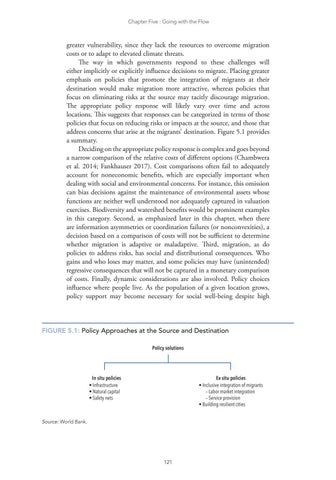Chapter Five : Going with the Flow
greater vulnerability, since they lack the resources to overcome migration costs or to adapt to elevated climate threats. The way in which governments respond to these challenges will either implicitly or explicitly influence decisions to migrate. Placing greater emphasis on policies that promote the integration of migrants at their destination would make migration more attractive, whereas policies that focus on eliminating risks at the source may tacitly discourage migration. The appropriate policy response will likely vary over time and across locations. This suggests that responses can be categorized in terms of those policies that focus on reducing risks or impacts at the source, and those that address concerns that arise at the migrants’ destination. Figure 5.1 provides a summary. Deciding on the appropriate policy response is complex and goes beyond a narrow comparison of the relative costs of different options (Chambwera et al. 2014; Fankhauser 2017). Cost comparisons often fail to adequately account for noneconomic benefits, which are especially important when dealing with social and environmental concerns. For instance, this omission can bias decisions against the maintenance of environmental assets whose functions are neither well understood nor adequately captured in valuation exercises. Biodiversity and watershed benefits would be prominent examples in this category. Second, as emphasized later in this chapter, when there are information asymmetries or coordination failures (or nonconvexities), a decision based on a comparison of costs will not be sufficient to determine whether migration is adaptive or maladaptive. Third, migration, as do policies to address risks, has social and distributional consequences. Who gains and who loses may matter, and some policies may have (unintended) regressive consequences that will not be captured in a monetary comparison of costs. Finally, dynamic considerations are also involved. Policy choices influence where people live. As the population of a given location grows, policy support may become necessary for social well-being despite high
FIGURE 5.1: Policy Approaches at the Source and Destination Policy solutions
In situ policies • Infrastructure • Natural capital • Safety nets
Ex situ policies • Inclusive integration of migrants – Labor market integration – Service provision • Building resilient cities
Source: World Bank.
121



